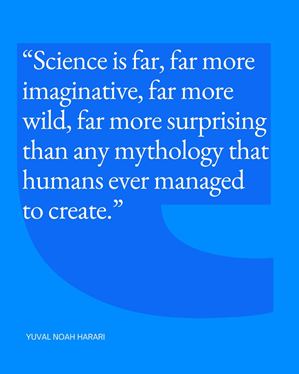Yuval is wrong.

(Yuval Harari posted this on 15/07/2025 to Instagram.)
“Homo Deus” is what he calls humans who have tossed the shackles of mortality, but somehow he doesn’t see the connection between science and mythology. Or maybe he does, and misses the imaginative foundation the latter gave the former. Yuval Harari is not a scientist; he is a science writer. Evidently, he is also not passionate about the origin of scientific thought.
This Instagram post by Mr Harari was captioned with:
Mythology takes human relationships and inflates them as if the whole universe works like our families. Before modern science, we couldn’t imagine atoms, black holes, or viruses and bacteria.
#LawsOfNature #NatureAndHumanity #YuvalNoahHarari #Mythology #Science
Harari has taken a singular aspect of mythology and inflated it to encompass the entire field. This isn’t new; science writers often comment on topics they haven’t studied enough (see: Hawking on Philosophy), but Harari isn’t just a popular science writer; he is also a medievalist, someone who should know better than to generalise historical foundations.
“Mythology takes human relationships and inflates them as if the whole universe works like our families.”
This may be true for the aspect of mythology that concerns the whims of gods and heroes. But do cultural origin stories really fall under this mantle?
Creation stories are from humans trying to come to terms with the world around them, as do humans who practice science.
Is the world surrounded by a giant serpent and propped up by a massive tree? Perhaps the cosmos was formed from a shapeless expanse that, chaotically, was ordering itself to create life! Or did life on Earth emerge only via transmutation from material from _another _planet?
All of these are questions that have, in some way or another, inspired scientific inquiry - and all of them are based on mythological creation myths.
Evolutionary theories (not merely Darwin’s theory of evolution, but ideas such as Lamarckism and spontaneous generation) are scientific attempts to continue thoughts brought forth by mythology on the origin of plants and animals.
The idea of the ‘Big Bang’ from approximately 13.8 billion years ago is a concept that, as much as it would like to, can not escape its resemblance to the creatio ex nihilo doctrine* that states that matter cannot be made out of nothing but must be from something, usually assumed to be divinely made. If the universe has a beginning, so theists say, then this beginning has to have been created.
The value of this assertion is not relevant here, but that it pre-dates the scientific theory is.
Even those who simply settle on: “ok, the matter (temperature meets high density, light particle, radiation,…) was always there”, cannot escape pre-existing mythological thought. Divine matter’s early cousin is the concept of creatio ex materia, in which matter has always existed, and _stuff _comes simply by transmutation of what is, and has always been, there. This theory doesn’t even always involve divinity. You cannot take the cosmology out of the cosmogeny if you want to make a true statement of how we arrived at the scientific ideas championed today. Science surprises, but it did not give its answers without us asking first.
“Before modern science, we couldn’t imagine atoms, black holes, or viruses and bacteria.”
Atoms: In some Buddhist schools, Kalapa are mentioned. These are indivisible units of matter, which are so small that they cannot be perceived unless one meditates about them. They are akin to elements and believed to make up all of what is there.
The Mu’tazilite school of early Islam posits that god has made the universe of indivisible parts. This religious theory explains that humans’ atomised nature makes them liable to judgement, as it means they themselves can determine actions, instead of being led by God directly.
Black Holes: Black holes, as spaces that devour everything, including light, are likewise not as mysterious as Harari believes.
Tartarus from Greek mythology represents both a god (one of the three primordial gods - the others being Earth and Chaos) and a place. He is the abyss, the punishment that destroys souls. Tartarus is a black hole, beyond what is known (described as below the underworld), and torturous by its nature.
Vishvarupa is a manifestation of the Hindu god Vishnu. It is the form that has no end and no beginning; it is so vast that it can not be handled by normal people. It is neither good nor bad - it is a black hole containing the entirety of the universe.
Viruses or Bacteria: I give Harari this one. Mythology didn’t really predict either viruses or bacteria, unless one is a bit more metaphorical (the Greek goddess Lyssa is a representation of rabies, and Greek god Proteus tells everyone the future who can capture him - thus, he changes shape to escape, and is used to represent Proteus mirabilis, a bacterium associated with UTIs which changes shape into a different cell type when it encounters solid surfaces).
“Science is far, far more imaginative, far more wild, far more surprising than any mythology that humans ever managed to create.”
Science is wild and surprising. The solutions science has come up with, discarded, and reimagined are fascinating and awesome. But mythology is more than god A and goddess B had a baby, and this one was human. Mythology is the basis for human questions about what the universe is all about, what we and all that is, are made of, where we come from and where we are going. Mythology inquires about the how, the where, the what and the why.
Science, together with its important siblings philosophy and history, refutes, confirms and reshapes those questions.
For a historian and writer on big science, Mr. Harari is curiously unable to draw connections between the before and the after. Sapien he is, Homo Deus? No.
